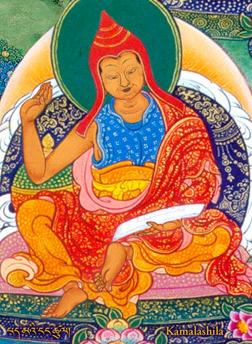
Kamalashila was a great Indian scholar and the main disciple of the Abbot of Nalanda Monastery, Shantarakshita. Shantarakshita (725-788) is considered the last of the great Indian Buddhist scholars whose masterpiece, the Madhyamakalamkaravrtti (The Ornament of the Middle Way), attempted to integrate the philosophies of the Madhyamaka, Yogachara, and the Logico-epistemology of Dharmakirti. Shatarakshita had gone to Tibet at the invitation of the Tibetan king Trisong Detsen (742-787) to help establish Buddhism in Tibet starting around 763. The local spirits and Bon religion were so strong that he was forced to leave, but returned with the great tantric master Padmasambhava, who was able to use his supernatural powers to appease the hostile spirits and enable Shantarakshita to establish Samye, the first monastery in Tibet, where he remained as abbot.
Although the Indian form of Buddhism that stressed a more gradual process to enlightenment became popular in Tibet, there was also an increasingly popular movement to introduce the Chan (Zen) form of sudden enlightenment. Shantarakshita had warned the king that if this became a problem, the king should invite his chief disciple, Kamalashila, to come to Tibet as Kamalashila was considered the most forceful and brilliant debater at the time. It is reported that in 792 a debate took place under the guidance of the king between Kamalashila and the Chinese master Ho Shang (Mahayana Hashang) and Kamalashila won. There are differing accounts of the results, but the Tibetan account is that the Chinese Buddhists were kicked out of Tibet and the Tibetans adopted the method of practice of the Indians as led by Kamalashila. There are also reports that the Chinese, in revenge, assassinated Kamalashila by squeezing his kidneys. The Chinese have a different version of the events.
I have always found this to be an interesting piece of history and have been looking for a translation of the three versions of the Bhavanakrama (Stages of Meditation) that Kamalashila wrote to explain the Indian approach to practice of Buddhist contemplative realization. I finally found such a translation that includes all three plus a fairly detailed history of the events as recorded by different sources plus two more Bhavanakrama by an Indian contemporary of Kamalashila, Vimalamitra (8th century). You can find them on Amazon in two books by Laul Jadusingh: The Progress in Meditation: The Three Bhavanakramas of Kamalashila and The Progress in Meditation: The Two Bhavanakramas of Vimalamitra: The Meaning of Gradual Entrance into Meditative Cultivation and the Meaning of Simultaneous Entrance into Meditative Cultivation. You can rent them free to read on Kindle or purchase the actual books. I believe they will be helpful to those of you who are studying the Buddha Master’s Imparting the Absolute Truth through the Heart Sutra and the course I am currently working on about Je Tsongkhapa’s Lam Rim.



Add comment